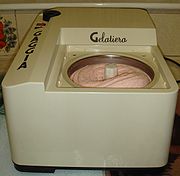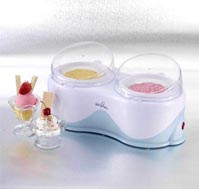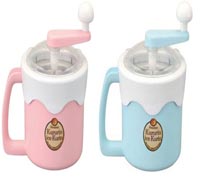
![]()
Ice Cream Maker
Be the owner of your own ice cream maker it means you can make mouth-watering homemade ice cream in as little as 20 minutes. Ice cream makers come up in a multiplicity of shapes and sizes; some are merely manual mixers which need the batch to be ice-covered for a few hours prior to its ready. Then an electric ice cream maker - with a built-in freezer it more often comes with detailed directions and recipes.
So mesmerized in using an ice cream maker at your home? Watch our ice cream videos you can create exciting, vivid variations, textures and flavors when you have your own ice cream maker. Make an impression to kids as well as your relatives, neighbors and friends at parties and other functions.
Manual machines
 These equipments typically consist of an outer bowl and a smaller inner bowl with hand-cranked machinery which turns a paddle, occasionally called a dasher, to mix the mixture. The outer bowl is crammed or filled with a freezing mixture of salt and ice: the addition of salt to the ice causes freezing-point depression; as the salt melts the ice, its heat of fusion allows it to absorb heat from the ice cream mixture, freezing the ice cream.
These equipments typically consist of an outer bowl and a smaller inner bowl with hand-cranked machinery which turns a paddle, occasionally called a dasher, to mix the mixture. The outer bowl is crammed or filled with a freezing mixture of salt and ice: the addition of salt to the ice causes freezing-point depression; as the salt melts the ice, its heat of fusion allows it to absorb heat from the ice cream mixture, freezing the ice cream.
This type of ice cream maker is economical or inexpensive, but inconvenient and messy as the ice and salt mixture produces a lot of salty water as it melts, which the user must dispose of, and the ice and salt mixture has to be replenished to make a new batch of ice cream.
Electric machines
 There are three types of electric ice cream machines. Each has an electric motor which drives either the bowl or the paddle to stir the mixture. The major difference between the three is in how the cooling is performed.
There are three types of electric ice cream machines. Each has an electric motor which drives either the bowl or the paddle to stir the mixture. The major difference between the three is in how the cooling is performed.
Counter-top machines use a double-walled bowl which contains between the two walls a solution that freezes below the freezing point of water. This is frozen in a domestic freezer for up to 24 hours before the machine is needed. Once frozen, the bowl is put into the machine, the mixture is added and the machine is switched on. The paddles rotate, stirring the mixture as it gradually freezes through contact with the frozen bowl. Twenty to thirty minutes later, the solution between the double walls of the bowl has thawed, and the ice cream has frozen. The advantage of this type of electric machine is low cost, typically under $100. The disadvantage of the pre-frozen bowl approach is that only one batch can be made at a time. To make another batch, the bowl must be frozen again. For this reason, it is usually possible to buy extra bowls for the machine, but of course these take
Picture of Ice Cream Makers


